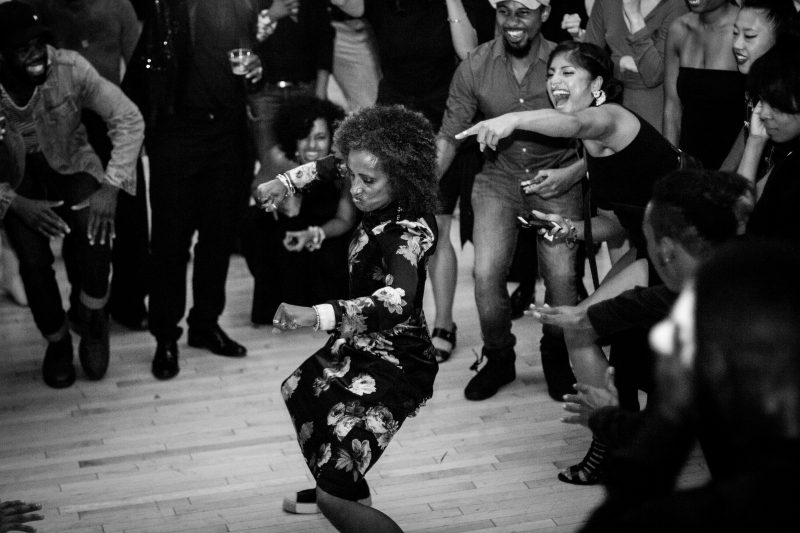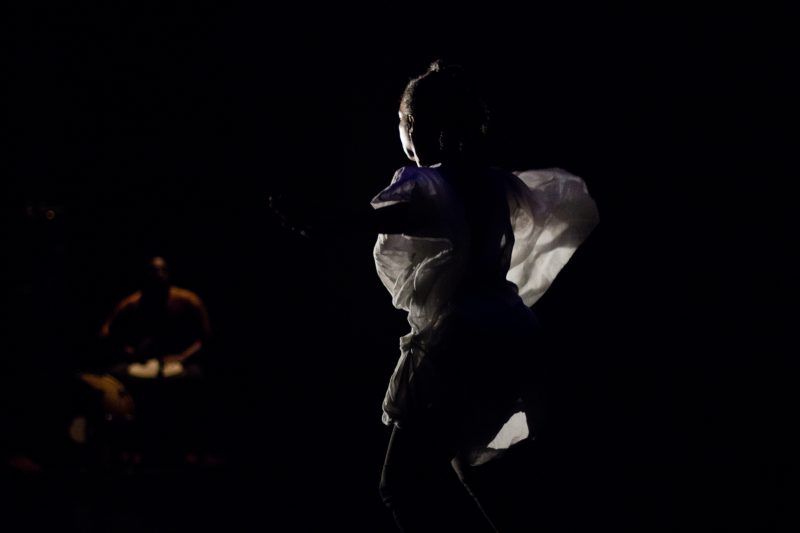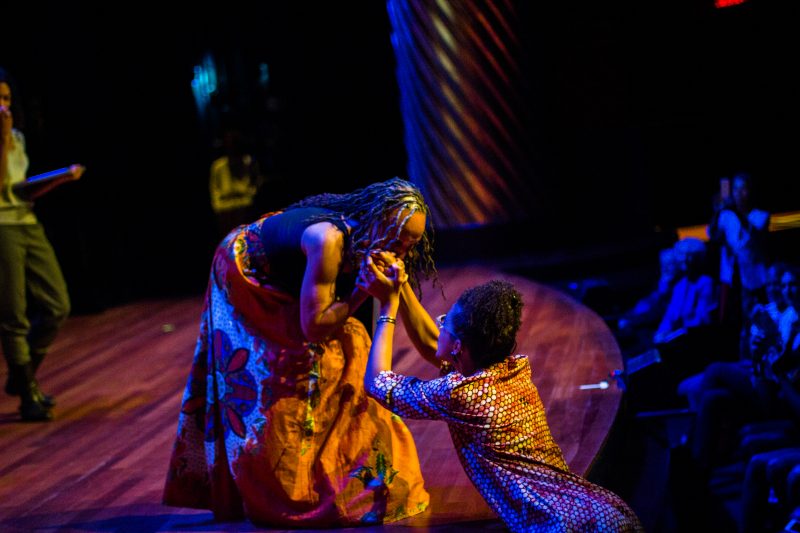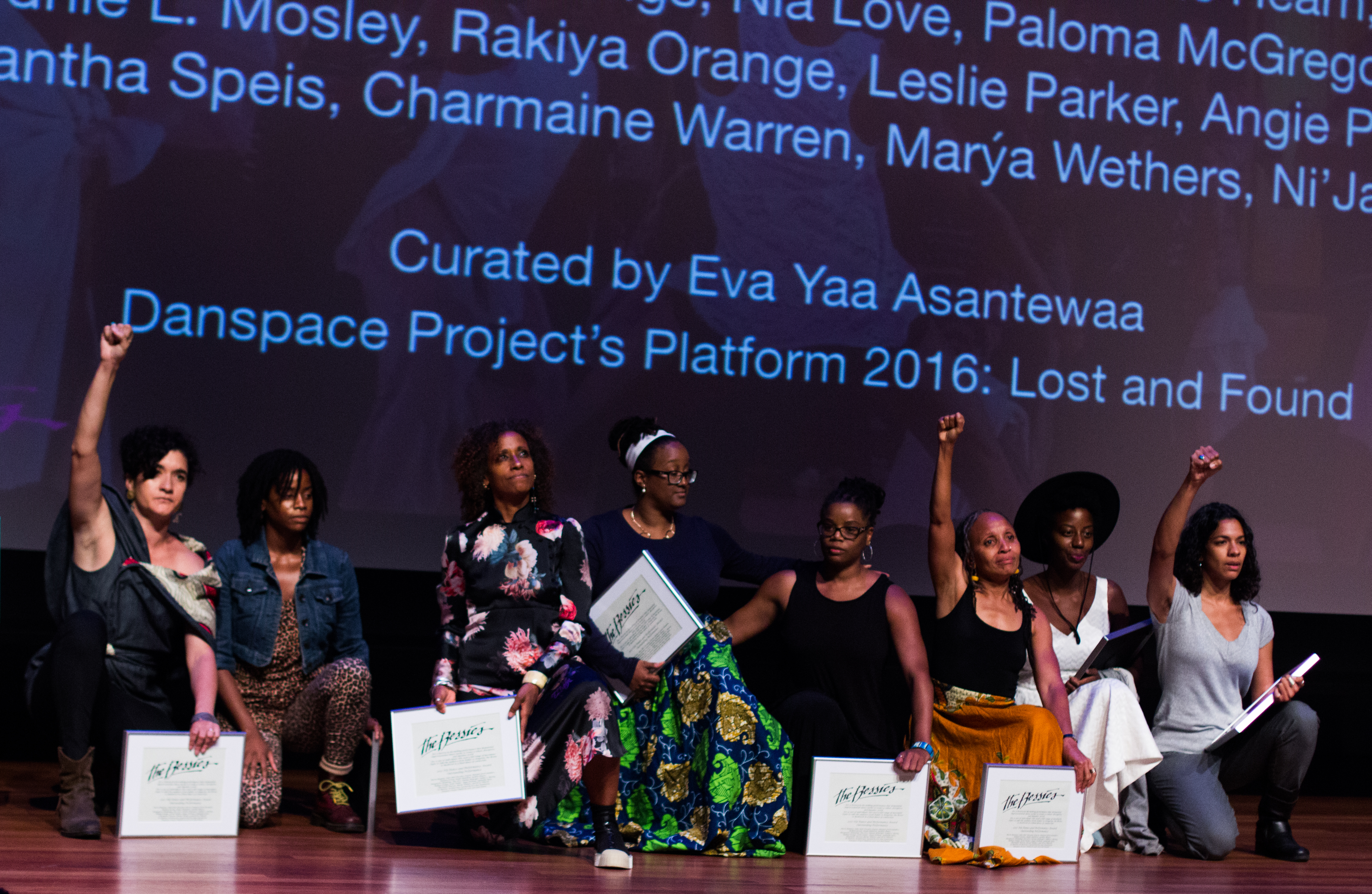The 2017 New York Dance and Performance Awards, also known as The Bessies, was an historic event featuring so many Black awardees that audience members began to tag #BessiesSoBlack in social media conversations. What made this Bessies so Black? Dianne McIntyre and Jonathan González were there. We invited these two artists, whose experiences span generations, to reflect on the significance of that awards ceremony and the impact and implications of a “Black Bessies” on the field at large.
The 2017 Bessie Awards ceremony in NYC was so much fun! Some people called it the Black Bessies. I say it was Normal Bessies. In the previous years when this major dance event was hosted by, attended by, applauded by, presented by, awarded to, geared to a primarily white downtown art crowd – was it called the White Bessies? No, it was the Normal Bessies and Status Quo Bessies. In the same vein let us claim 2017 as “Normal.”
I felt so at home throughout the evening. My first order of business was to mingle at the reception and then, along with Maurine Knighton, recognize Mikki Shepard for her extraordinary contributions to the field as a presenter, producer, consultant and cheerleader for artists of color. It was right for Mikki to be grandly celebrated! It was what was supposed to happen. It was not a Black thing – it was the truth. Though her thrust has always been focused primarily on Blacks in the arts, because of that focus, her energies have benefitted the entire field. I do not mean in just a “diversity” way. I mean that the introduction of many people of color into the wide world of performing arts has strengthened and enhanced that world in a most profound way.
This is the story of the entire 2017 Bessie Awards. As I mingled before the ceremony in the theatre I saw everybody I knew. People from every corner of the dance world were there. It was fun! And what an abundance of Black artists receiving awards – one after another after another and in groups. The joy and exhilaration of everyone there was explosive. Though the color of the individuals was a major shift from years before, the significance of each award was in the normalcy of what Bessie recognizes. Just like in the case of Mikki Shepard, these artists have added heft to the field of dance through their glorious work.

My next and most visible role that evening was presenting the Lifetime Achievement Bessie Award to Jawole Willa Jo Zollar. The moment I stepped onto the stage the audience gave me such a rousing, loving reception. It made me grin from ear to ear.
Let’s go back. I have received three Bessies – 1989, 1997, 2006. I accepted my awards at two ceremonies. When I walked out on stage each time, I knew the people did not know who I was. To them, I was like an alien in a strange land, and they were mostly unfamiliar to me. In fact, in one speech, I appeared with my collaborator, Olu Dara, and I opened by saying “I know you all do not know who we are.” And it was so; they did not have a clue. Once in the 1990s, David White (previously director of Dance Theatre Workshop, now NYLA) made a comment. He told me he had been Uptown at Riverside Church to a Chuck Davis concert. He was flabbergasted that he did not know anyone in that packed audience, although he was a major player in the dance world. He said he began to realize our dance worlds were separate. Worlds apart in the same city.
The 2017 Bessie Awards ceremony unified those worlds. I just felt comfortable. I knew the folks of all different backgrounds, and they knew me. It was a feeling I had as a child for what dance is – what a dance family is. In my vision as a child it did not have a racial color. It was dance! The Oh So Black Bessies of 2017 made this year’s ceremony, not out of the ordinary, but what it should be every year.
Reflections from Dianne McIntyre

“I came, I saw, I take what’s mine, then take some more.”
Praise the Lord (Da Shine), A$AP Rocky featuring Skepta
Black Excellence is contingent on the killing of the Master.
The ferocity of appropriation in the contemporary technodigital imaginary consumes culture – culture, as in that circulating commodity of slippery aesthetics with a pulse known as blackness – at an accelerating pace; leaving little trace of origin, inheritance, or an author’s lineage in its wake. The capitalist regime of art knows this well — laissez-faire. All is achieved accordingly as we cheers to another evening. Subjects of the periphery (non-white) who produce art, or produce life, know this ardently in their bones. Our neoliberal holding is not dissimilar to the bowels of the slave ship. We take heed in the proverbial cage — a cold entrapment where the subjected (non-human=black subject=black artist) create under the bounds of continual dispossession. We wrestle to grasp our work for just one more second, struggling for viewership and a more accurate lexicon to continue the lifeline of said work beyond the stage (wherever that exist) as it slips into the immaterial helter-skelter of the omnipresent white imaginary critique.

In the semi-filled NYU Skirball Center, we maintain good relations as an itch burrows into the fabric of the ritual. Periodically, it swells to a burn fiery and blue in the traces of each announced nomination. Syllabic echoes from the quadraphonic sound radiate through the theater’s rafters and reveal a shared cosmology: Am I meant to be here? A history of unsung griefs and their corresponding unsung heroes amplify a fear greater than the container of any one Black body. A hereditary ache appears as the Imposter Syndrome sets in with a familiar form.
No church in the wild, and no reason for networks of intimacy when the wild still remains an elusive “diplomatic” gauntlet for acknowledgment of the exceptional few.
#thehustlemademedoit
[A breath comes from the announcer as we await the envelope unfolding to reveal the winner]
They stand overexposed at the podium almost in full cognition of the fragility in this partnership. A bittersweet tale of us and them. Perhaps they enjoy the power. Either way, we, the congregation, wait.

Another glass of Prosecco and a photo of your outfit beginning to crease remind you this will all be over.
This holding is nothing in comparison to living. But, like a drop of iodine spreading out and through water, your veneer of lighthearted affect negotiate an expanding underbelly both tragic, and comically dire.
The communion of Black non-being and desire catalyze chemical responses of unstandardized proportions. This spontaneous combustion sounds like:
1. Wanting to know want as your own
2. Wanting through measures of your individual potential as if your body can be unbound
3. Wanting recognition within the bounds of a hypothetical objectivity when the initial object is a fetish of you: the Black body = Black gold. Can you shuck-and-jive?
Legibility is counter-intuitive when locating Blackness, unless one packages it. To know what you are with fixity is a belief in the clarity of the spoken word, and an ideology crafted in the principles of the white phallus. Understand, pigment is arbitrary here (we can all buy and YouTube tutorial our way into Black™) but your method of translation (for whom and how you spin) is de rigueur.
Fuck it, we made it!
Yes, you’ve been working so hard for so long, and wouldn’t the guise of meritocracy be sweet? A catapult of opportunities to follow.

Instead, let us set the theater afire! Liquify each award into a golden intoxication as we bathe and devour ourselves away from these territories of acknowledgment that will not have us beyond this fascistic cultural moment. I know, how utopian… but form, as is employed in this carceral rat-race of artistic recognition, is disastrously archaic to the multidimensional engagement that makes up our everyday liveness; our survivability. Death is real and imminent for all, and impending for some more than others.
Imagine yourself a fly in the room of a Bessies committee meeting. A shuffling of coffee-stained evaluations and testimonies about the skilled. For how long do you stay?
Down with the institution! And, then what? Nothing is sustained until the frameworks testify to an intimate emancipation — a more-than-representation, more-than-decolonial collaboration of -ism-based amendments. Maybe a critique cultivated in radical Black imaginaries would be collapsible…a queer form without check-boxes of identitarian prescriptions. Where would we locate success in all of this nomadic mess? Would it matter? Would mattering make sense here?
Therefore, Blackness must have always been an accumulation, an ancestral project of returning, instead of the severing post-post-post predecessor doctrine that populates our archives, and the nomenclature of historical art cannons. This Blackened tentacular place might recall that the matrices of recognition are failures composed at the synapses of the colonizer meant to distinguish an inferior; to proclaim one’s property. This Blackened tentacular place would identify the archetypes of genius as fathomed through musings of that colonial-realized-subject where innovation is always also a weapon. Can we willfully refuse the barricades of the indoors and forgo a seat at the table for the outside? Then, perhaps all around us, would begin the long-awaited collapse as we wield desire in the wild of our own collaborative making.
Reflections from Jonathan González
